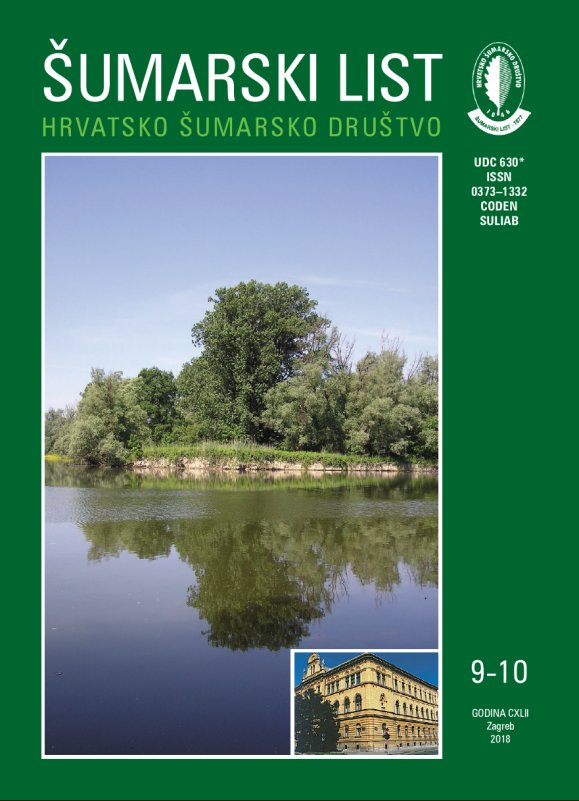
broj: 9-10/2018
pdf (10,64 MB) |
|
||||||||||||||
| RIJEČ UREDNIŠTVA | ||
| Uredništvo | ||
| On the occasion of the 120th anniversary pdf HR EN | 457 | |
| IZVORNI ZNANSTVENI ČLANCI | ||
| Krunoslav Teslak, Marijana Žunić, Karlo Beljan, Jura Čavlović | UDK 630* 923 + 619 (001) https://doi.org/10.31298/sl.142.9-10.1 | |
| Status and challenges of small-scale private forest management in actual ecological and social circumstances – Croatia case study pdf HR EN | 459 | |
| Luka Kasumović, Ake Lindelöw, Boris Hrašovec | UDK 630* 453 (001) https://doi.org/10.31298/sl.142.9-10.2 | |
| Influence of predator abundance and winter mortality on reproduction of bivoltine populations of Ips typographus L. (Coleoptera: Curculionidae) pdf HR EN | 473 | |
| Mirna Mihelčić, Josipa Habuš, Marko Vucelja, Petra Svoboda, Ivan-Christian Kurolt, Alemka Markotić, Nenad Turk, Josip Margaletić, Marina Šantić | UDK 630* 443 + 451 (001) https://doi.org/10.31298/sl.142.9-10.3 | |
| Prevalence of Francisella tularensis in the population of small mammals species in continental forests of Croatia pdf HR EN | 481 | |
| Silvija Šiljeg, Ivan Marić, Gojko Nikolić , Ante Šiljeg | UDK 630* 451 + 153 (001) https://doi.org/10.31298/sl.142.9-10.4 | |
| Accessibility analysis of urban green spaces in the settlement of Zadar in Croatia pdf HR EN | 487 | |
| Mădălina Fornea, Marcian Bîrda, Stelian Alexandru Borz, Bogdan Popa, Željko TomaŠić | UDK 630* 360 (001) https://doi.org/10.31298/sl.142.9-10.5 | |
| Harvesting conditions, market particularities or just economic competition: a Romanian case study regarding the evolution of standing timber contracting rates pdf HR EN | 499 | |
| Ali Bayraktar, Fahrettin Atar, Nebahat Yildirim, Ibrahim Turna | UDK 630* 181.5 (001) https://doi.org/10.31298/sl.142.9-10.6 | |
| Effects of different media and hormones on propagation by cuttings of european yew (Taxusaxus baccata L.) pdf HR EN | 509 | |
| Vanja Daničić, Branislav Kovačević, Dalibor Ballian | UDK 630* 164 (001) https://doi.org/10.31298/sl.142.9-10.7 | |
| Variability in fruit morphology of european sweet chestnut (Castanea sativa Mill.) in natural populations in Bosnia and Herzegovina pdf HR EN | 517 | |
| Summary The European sweet chestnut (Castanea sativa Mill.) is the only native species of the genus Castanea in Europe. The sweet chestnut has a remarkable multipurpose character, and may be managed for timber production as well as for fruit production, including a broad range of secondary products and ecosystem services. Chestnut in Bosnia and Herzegovina is mainly located in the northwest Una-Sana Canton, east (Bratunac and Srebrenica) and south (Konjic and Jablanica) where grows within the forest. In B&H European sweet chestnut is a species which is not paid enough attention and it is one of the rarest and critically endangered tree species. The variability of sweet chestnut fruits in six natural populations in B&H using a morphometric analysis was investigated. The samples of sweet chestnut for this study were collected from the six separate gographic localites in B&H (Figure 1) in year 2012. The populations were represented with 10 trees each and each tree with 20 fruits. A total of 1200 fruits and 13 morphological characteristic were analyzed. Fruits morphological characteristics were described by descriptive statistical indicators: arithmetic mean (), standard deviation (Sd), coefficient of variation (Cv) (Table 1 and 2). In order to determine the intrapopulation and interpopulation variability the univariate analysis of variance (ANOVA) was performed (Table 3). Results obtained by statistical analysis of studied morphological characteristics of chestnut fruits showed that the most variable characteristic is the weight of the fruit (Cv = 34,5 %). Medium values of fruit weight of analyzed samples was within a range from 4,38 to 5,77 g (average 4,93). Lower variability coefficients are propere to the width (Cv = 10,8 %) and height of the fruit (Cv=13,15%). In B&H populations prevails typical brown chestnut color of the fruit. The analysis of variance (ANOVA) confirmed presence of statistically significant differences by all studied characteristics on both inter- and intra-population level. According to cluster analysis studied populations are agglomerated in three clusters (Figure 3.). However, this was not confirmed by canonical discrimination analyzis (Figure 4), by three populations formed core within well defined data claud. We assume that differences between results of two methods are probably based on the fact that cannonical discrminate analysis include information about variability within population in the process which cluster analysis does not. High variability in populations is very important for the conservation of genetic pool of the species. For a complete knowledge on the variability of European sweet chestnut in a part of the natural area the research should be expanded by the use of molecular markers. Key words: European sweet chestnut (Castanea sativa Mill.); morphological characteristics; fruit; multivariate analysis; Bosnia and Herzegovina | ||
| PREGLEDNI ČLANCI | ||
| Xiaoyang Zeng | UDK 630* 114.2 + 272 https://doi.org/10.31298/sl.142.9-10.8 | |
| Influence of tourism disturbance on carbon, nitrogen, and enzyme activities of the soil in an urban park in China pdf HR EN | 529 | |


